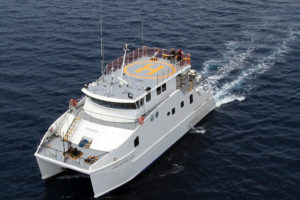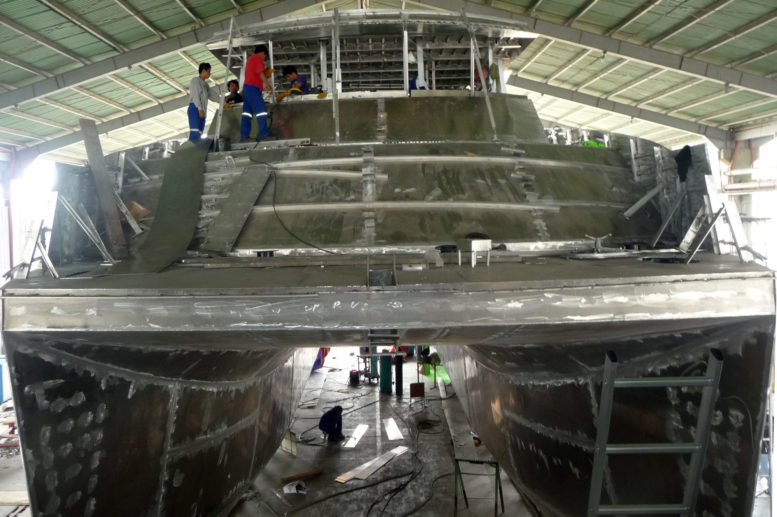I refer to this issue’s topic as Shipbuilding Issues 2016 since the subject seems to appear herein ad infinitum, primarily when taken from the proceedings of the Maritime Forum, which we hold 10 times annually.
Ten years ago in the MR 06-4 (Jul-Aug 2006) issue’s Chairman’s Page, I wrote about the Japanese Shipyard Tsuneishi’s expansion plans in Balamban, Cebu after completion of its third slipway that would enable them to build a large bulk carrier every 3 weeks, or 15 annually. We were on the way then to being no. 6 in the world in shipbuilding. Today we are no. 4 but our domestic shipbuilders are still not happy.
In that column, I also mentioned, on the domestic shipbuilding dimension, an item about the nearby FBM Babcock Marine (A UK-Filipino joint venture) that was capable of building world class fast ferries comparable with the best in the world that made Columnist Bobit Avila comment,
That means that the greatest nations on this planet believe in the workmanship and quality of Filipino-made products. Surely, we can see the enormous benefits that the FBM Babcock Marine offers to the Philippine Navy or the Coast Guard. Yes, we can build those Coast Guard cutters right in our own backyard instead of buying used ones from abroad! Hence, the question: Why isn’t the Philippine Navy, which has been dubbed as a Navy without ships, ordering any from Balamban? I really have no answers to this!
I did add that we addressed the issue of government – particularly Navy and DOTC – support to the shipbuilding industry in several forums in 2004 and 2005, and former PN Flag Officer in Command VADM Ernesto de Leon took the cue but unhappily the government could not provide the necessary support, budget wise. I stated that the modernization program was temporarily stalled by lack of funds, but we should keep on pushing and that “I still believe that Philippine government agencies, including the PN, PCG and departments and bureaus that have need for ships, should as far as practicable avail of local shipyards.”
One indicator then that positive steps could be taken was the construction of a vessel purposely built by Herma Shipyard in Mariveles, Bataan (which constructs world-class petroleum carriers for its sister company, Herma Shipping) for medical purposes, the 30-ton, 16-meter-long specially designed and fully equipped boat with an 8-member staff that docked in remote areas of the archipelago to fulfill a mission: Provide free orthopedic devices for those in need. I wonder how that eventually fared? Given that we never heard about it during the Yolanda disaster, did it suffer the same fate as the Navy’s modernization?
It would also seem that the experience of the Yolanda would spur the effort to acquire hospital ships and logistic support vessels, something that was initiated in the ‘60s and ‘70s, as the PN actually constructed its first hospital ship in the ‘60s. Some other interesting developments were covered in that column (including a plan by our Executive Editor, Vicky Viray Mendoza, who was then still working with the World Bank’s IFC, to convert a vessel to a hospital ship; it can be pulled out by searching it in our web page in www.maritimereview.ph.)
That column was read by then Rep. Loretta Ann “Etta” Pargas who, addressing me, posted in the Navy Forum (26 June, 2006):
I have recently come from a Jakarta meeting of ASEAN MPs on the issue of democratization in Burma. While waiting for my plane in the airport, I had an engaging conversation with Ms Brenda Pimentel from the UN IMO and several Filipino seafarers on the importance of shipbuilding as a major industry that must be developed in the Philippines. I related my story of how I spoke to – I am not sure if it was Vice Admiral de Leon or some other Admiral – about the possibility of having the Philippine Navy develop its capacity for ship building and he said of course, it is possible. And here are your articles, Chuck saying that it is the budget problem that is stopping us from going into this.
Has the AFP or the Phil. Navy ever made a feasibility study complete with projections of the benefits of the ship building industry in terms of generating capital for the economy and jobs for the people? And to compare this with the cost of building the industry locally? Likewise, what impact this would give our economy and our seafarers? And later, how this can develop our competitive strength not only in local commercial shipping but in international shipping? These questions may sound simplistic but they do address a basic attitude with respect to long term planning on industrial development.
As I mentioned above, we have addressed this matter so long but do not seem to get anywhere.

23-Meter Hydrographic Aluminimum Catamaran boats built for the National Mapping and Resource Information Authority of the Philippines by Colorado Shipyard Corp. Photo Courtesy of: Colorado Shipyard.
There are however a few positive developments. The NAMRIA has constructed through a local shipyard two small survey ships that are now operational. The PCG should follow suit. The PN should be allowed to procure non-combatant service vessels under the same standards used by NAMRIA. The MARINA is today supportive of positive action to help domestic shipbuilders and has a periodic SBSR Forum with them.
During the 109th Maritime Forum in Cebu last 11 Feb the issue of government neglect arose when inadvertently the MARINA briefing stated some under capacity of local shipyards, and the shipbuilders responded that the problem is not under capacity but under-utilization due to lack of orders because the importation of used vessels, primarily from Japan, goes unabated. We then agreed that the shipbuilders would put together an issue paper and present it in the next Forum. That did not happen, but during the following 111th Forum hosted by MARINA at the Manila Yacht Club, it was agreed that an Executive Session should be held to finalize a presentation to be made in the 112th Maritime Forum in May, which can then agree to endorse it for action by MARINA and the government.
Will we finally get some positive action that can really start the domestic shipbuilders on the path of adding much more to the growth of our shipbuilding industry? To me, these are some of our needs:
- Providing cheap money to the shipbuilding industry on a long-term loan, much the same way that HLURB and PAG-IBIG now provides cheap money on long-term housing loans at around 6%, specifically for the homeless.
- Implementing MARINA’s mandate for shipbuilding development, as suggested by a colleague, Commo. Terry de la Cruz;
- Developing a unique world-class Philippine classification society which is a sine quanon for maritime development as a shipping nation, and a long-time personal passion.
- Providing more facilities, incentives and support for skills training;
- Immediate reviewing of the New Procurement Act as applicable to the PN and PCG;
- Expanding the SBSR Forum that MARINA holds regularly to make it transparent and more productive;
- Getting the two Transportation Committees in Congress staffed with competent people and led by dedicated transport industry-thinking members; and
- Further reducing SBSR bureaucracy in MARINA through innovative means.
I still feel and hope that shipbuilding will be a major engine of growth of the Philippine economy, much the same way as Japan did from the ‘50s, and South Korea and Taiwan in the late ‘50s to the ‘90s.
The big players here have taken off on the international market. Should it be about time for the Philippine domestic shipbuilders to have a good shot at it?

I am looking for a catamaran type passenger with cruising speed of 24 to 26 knots. 200 pax capacity.